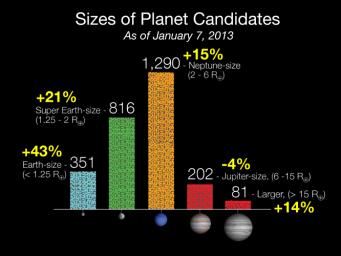Since the last Kepler catalog was released in February 2012, the number of candidates discovered in the Kepler data has increased by 20 percent and now totals 2,740 potential planets orbiting 2,036 stars. Based on observations conducted May 2009 to March 2011, the most dramatic increases are seen in the number of Earth-size and super Earth-size candidates discovered, which grew by 43 and 21 percent respectively.
Scientists analyzed more than 13,000 transit-like signals called 'threshold crossing events' to eliminate known spacecraft instrumentation and astrophysical false positives, phenomena that masquerade as planetary candidates, to identify the potential new planets.
The complete list of Kepler planet candidates is available in an interactive table at the NASA Exoplanet Archive. The archive is funded by NASA's Exoplanet Exploration Program to collect and make public data to support the search for and characterization of exoplanets and their host stars.
Ames manages Kepler's ground system development, mission operations and science data analysis. NASA's Jet Propulsion Laboratory in Pasadena, Calif., managed Kepler mission development. Ball Aerospace and Technologies Corp. in Boulder, Colo., developed the Kepler flight system and supports mission operations with JPL at the Laboratory for Atmospheric and Space Physics at the University of Colorado in Boulder.
The Space Telescope Science Institute in Baltimore archives, hosts and distributes the Kepler science data. Kepler is NASA's 10th Discovery Mission and is funded by NASA's Science Mission Directorate at the agency's headquarters in Washington.
JPL manages NASA's Exoplanet Exploration Program. The NASA Exoplanet Archive is hosted at the Infrared Processing and Analysis Center at the California Institute of Technology.
For information about the NASA Exoplanet Archive, visit: http://exoplanetarchive.ipac.caltech.edu/index.html.
For information about the Kepler mission, visit: http://www.nasa.gov/kepler.

 Planetary Data System
Planetary Data System












